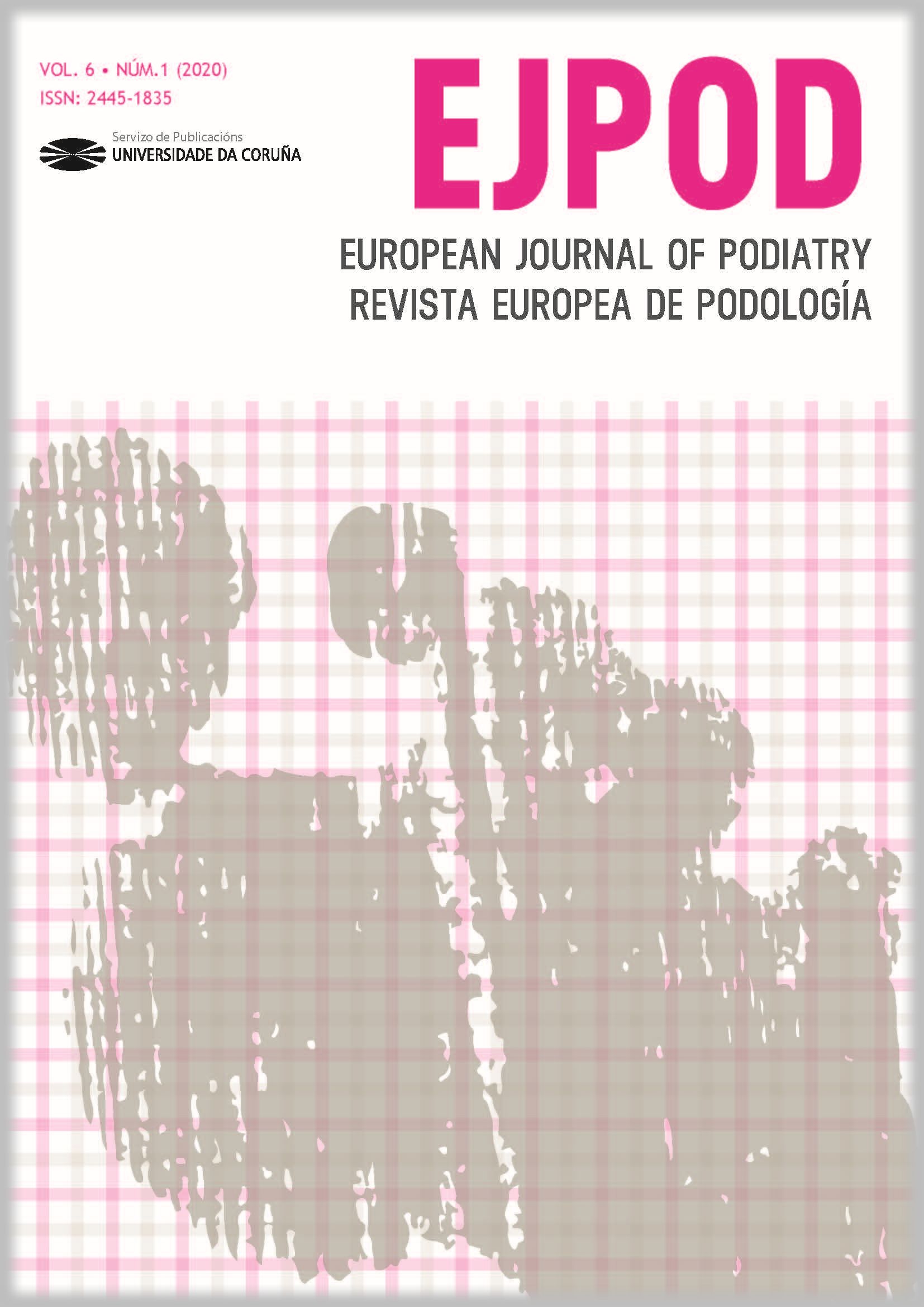Efectividad del vendaje neuromuscular en pacientes con retracción de la musculatura posterior
Contenido principal del artículo
DOI:
https://doi.org/10.17979/ejpod.2020.6.1.6540Resumen
Objetivos: los objetivos de este trabajo son validar el vendaje neuromuscular como terapia en pacientes con retracción de la musculatura posterior y valorar tano una posible variación del centro de gravedad como en la flexión dorsal de tobillo.
Material y métodos: estudio observacional, transversal, prospectivo y multicéntrico en el que se seleccionó una muestra de 21 sujetos atendidos de forma consecutiva a los que se les realizó un estudio mediante goniometría y baropodometría con y sin vendaje neuromuscular.
Resultados: 21 pacientes (8 mujeres y 13 hombres) muestran una flexión dorsal de tobillo con diferencias estadísticamente significativas tras la terapia, ya que se consiguió aumentar una media de 3,09 ± 2.23° con la rodilla extendida (p = 0.00005) y 2.24 ± 2.59° con la rodilla flexionada (p = 0,001) en una pierna y 2.91 ± 3.25° (p = 0.002) y 2.71 ± 2.81° (p = 0.0005) con la rodilla extendida y flexionada respectivamente en la otra. Asimismo, el test de Lunge también mostró un aumento articular promedio de 2.76 ± 2.84 centímetros (p = 0.0005) en la pierna derecha y de 2.67 ± 3.18 (p = 0.003) centímetros en la pierna izquierda.
Conclusiones: el vendaje neuromuscular muestra evidencia científica en su aplicación en pacientes con retracción de la musculatura posterior. La posición del centro de gravedad varía tras el uso de esta terapia, aunque no de forma significativa, y se puede obtener un aumento de la flexión dorsal de tobillo de hasta 3° de media aproximadamente.
Palabras clave:
Detalles del artículo
Referencias
Kase K. What is the kinesio taping method? [Internet]. kinesio. The original from Dr. Kenzo Kase since 1979. 2016. Available from: https://kinesiotaping.com/about/what-is-the-kinesio-taping-method
Kase K, Wallis J, KaseTsuyoshi. Introduction to Corrective Techniques. In: Clinical Therapeutic Applications of the Kinesio Taping Method. Tokyo: Ken Ikai Co.; 2003. p. 19-39.
Zhang XF, Liu L, Wang B Bin, Liu X, Li P. Evidence for kinesio taping in management of myofascial pain syndrome: a systematic review and meta-analysis. Clin Rehabil. 2019;33(5):865-74.
Kul A, Ugur M. Comparison of the Efficacy of Conventional Physical Therapy Modalities and Kinesio Taping Treatments in Shoulder Impingement Syndrome. Eurasian J Med. 2019;51(2):138-43.
Busquet L. Las Cadenas Musculares. Tomo IV. Miembros Inferiores. 4a edición. Casals N, editor. Barcelona: Editorial Paidotribo; 2001. 119-121 p.
Honeine J-L, Schieppati M, Gagey O, Do M-C. By counteracting gravity, triceps surae sets both kinematics and kinetics of gait. Physiol Rep. 2014;2(2):e00229.
Kirby KA. Equilibrio Rotacional en el Pie y la Extremidad Inferior. In: Vergés Salas C, editor. Biomecánica del Pie y la Extremidad Inferior IV: Artículos de Precision Intricast, 2009-2013. 1a edición. Barcelona: Precision Intricast Inc; 2016. p. 9-10.
Kirby KA. Equilibrio Rotacional a través de la Articulación del Tobillo. In: Vergés Salas C, editor. Biomecánica del Pie y la Extremidad Inferior IV: Artículos de Precision Intricast, 2009-2013. 1a edición. Barcelona: Precision Intricast Inc; 2016. p. 11-2.
Duysens J, Beerepoot VP, Veltink PH, Weerdesteyn V, Smits-Engelsman BCM. Proprioceptive perturbations of stability during gait. Neurophysiol Clin. 2008;38(6):399-410.
Andreo P, Khalaf K, Heale L, Jelinek HF, Donnan L. Effects of Kinesiology Tape on Non-linear Center of Mass Dispersion During the Y Balance Test. Front Physiol. 2018;9(October):1-8.
Nunes G, Noronha M de, Cunha H, Ruscherl C, Borges N. Effect Of Kinesio Taping On Jumping And Balance In Athletes: A Crossover Randomized Controlled Trial. J Strength Cond Res. 2013;27(11):3183-9.
Davison EA, Anderson CT, Ponist BH, Werner DM, Jacobs ME, Thompson AJ, et al. Inhibitory Effect of the Kinesio Taping® Method on the Gastrocnemius Muscle. Am J Sport Sci Med. 2016;4(2):33-8.
Boozari S, Sanjari MA, Amiri A, Ebrahimi I. Effect of Gastrocnemius Kinesio Taping on Countermovement Jump Performance and Vertical Stiffness following Muscle Fatigue. J Sport Rehabil. 2018;27(4):306-11.


